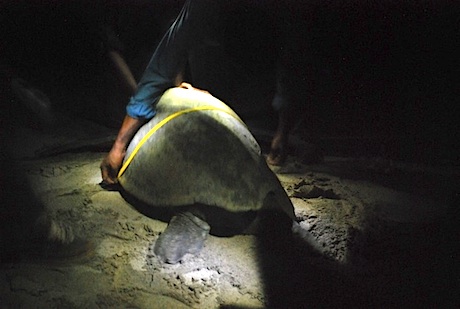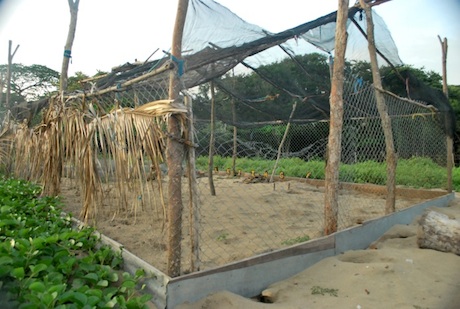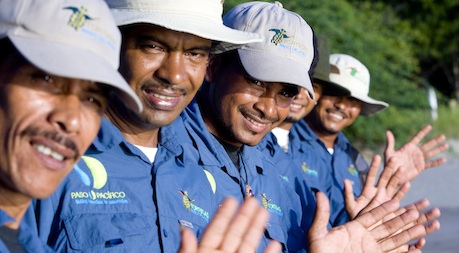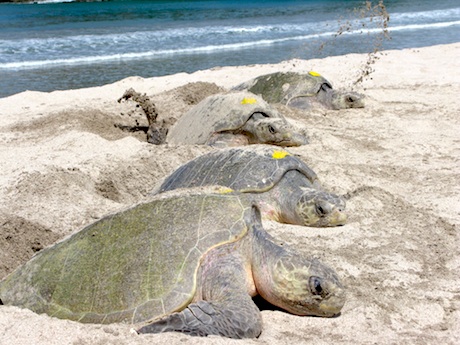The project has helped to strengthen the community-based protection of nesting sea turtles along the Pacific coast of Nicaragua.
Achieving Program Goals
1) Promote sustainable tourism linked to sea turtle conservation
In Pasa Pacifico, the local community tour guides benefited from 100 volunteer shifts from international student groups who provided recommendations whilst working along side the guides. This training has improved the interpretation and visitor attention provided during sea kayak and nesting turtle tours.
Additionally, $3,000 was generated for turtle conservation, and more than $4,000 spent in local communities.
In regards to promotion of sustainable tourism, SEE Turtles director Brad Nahill visited the project site and will promote turtle tourism through blog posts and photography, also helping to connect Paso Pacifico to tour operators including Reefs to Rockies, Broad Reach, and EcoTeach.
SEE Turtles is also working to promote volunteer programs to other turtle sites in Nicaragua connected to this location.
2) Build capacity for sea turtle tourism and stewardship
Local capacity was built through ranger training focused on the application of digital PIT tags and satellite transmitters, enabling improved monitoring of sea turtles nesting at beaches protected by community rangers.
A workshop on sea turtle first aid was given to community-based rangers during which rangers learned techniques to rescue and revive sea turtles caught in fishing gear or impacted by boats.
Capacity was also increased through the purchase of basic monitoring equipment and supplies (baskets for turtle nurseries, flashlights, batteries, and repellent). Also, new UV-protective uniforms were purchased for rangers and for the local women who manage and protect the sea turtle nursery within the community of Ostional.

Photo: Paso Pacifico rangers working with a green turtle (Photo: Brad Nahill / SEEtheWILD)
3) Empower local people in protecting nesting sea turtles.
This project also contributed to the salaries of community-based rangers. These eight rangers, some of whom were former egg poachers, work full time patrolling beaches and collecting valuable scientific data. Communities also benefited economically from these jobs.
The rangers also serve as ambassadors within the community and recently led a “Junior Ranger” program which enabled over one hundred children to earn badges for successfully completing environmental curriculum and for carrying out environmental service projects in their communities. The Junior Rangers have graduated and many of them continue to assist rangers and researchers in turtle and parrot monitoring as well as in coastal clean-ups.
This project enabled the protection of over eighty sea turtle nests, of which more than half were endangered Eastern Pacific green turtles. Several critically endangered hawksbill sea turtle nests were also successfully protected.

Photo: Hawksbill shell jewelry (rings) at a market in Granada (Brad Nahill / SEEtheWILD)
Challenges
In the sea turtle nursery located in the community of Ostional, the initial hatchery site had to be abandoned after successive damage from storms and high tide. A sea turtle hatchery has been launched at a new site and is currently being managed by a group of five local women.
What's next for this project?
The sea turtle protection activities made possible through this grant continue today and additional support is needed. We plan to continue our financial and technical support to local women in their efforts to protect sea turtles nesting at the Ostional community beach. For the ranger program over the next year, we would like to purchase additional monitoring and safety equipment, provide first aid and monitoring training, and we plan to continue to support a fair-wage and stable employment for the rangers who risk their lives to protect some of the world’s most endangered reptiles.
Can I visit this project?
Sure, Paso Pacifico staff are always open to visits! Contact SEE Turtles for more info about trips to Nicaragua.
Also, read Brad Nahill (SEE Turtles) blog post about visiting this Pasa Pacifico turtle site.

Photo: Turtle hatchery run by Paso Pacifico (Brad Nahill / SEEtheWILD)
Project Cost covers:
On the ground, funding will go to support community based sea turtle conservation at a globally important sea turtle nesting area.
First, funds will support community rangers who will protect nesting sea turtles at three priority beaches. Funds will help cover ranger salaries and will also support the purchase of supplies for these rangers, primarily, solar powered flashlights, sun hats, and life jackets.
Second, funds will be used to support a sea turtle hatchery at the Ostional beach that is managed by a group of women from the same community. We will purchase materials to build interpretive signs and for improved monitoring of the nests (i.e. purchase of thermometers, nest-markers, baskets). The women’s sea turtle hatchery will be prepared to receive tourists who would like to learn about sea turtle life history.
In addition, a portion of the funds will support marketing and outreach activities to encourage US travellers to visit these communities and create viable sustainable tourism.
Objectives, Aims, and Outcomes
The primary aim of this project is to increase the long-term protection of endangered sea turtles in Nicaragua and the Eastern Pacific
Specific objectives include:
- Promote sustainable tourism to increase economic development linked to sea turtle conservation
- Build local capacity for sea turtle tourism and natural resource stewardship
- Empower local people in protecting nesting sea turtles from illegal poaching activity
The result of the project will be an improved sea turtle hatchery managed by local women, a strengthening of sea turtle protection activities led by local rangers, and increased income to community-based tourism businesses and a community-run sea turtle hatchery.

Background on current situation
Sea turtles throughout the world’s oceans are threatened, and species such as the Leatherback (Dermochelys coriacea) and Hawksbill (Eretmochelys imbricata) turtles of the Eastern Pacific are nearing extinction (Sarti-Martínez et al. 2007, Chaloupka et al. 2004). Four different species nest along Pacific beaches of Southern Nicaragua at the project site, these are: Olive Ridley (Lepidochelys olivaceae), Hawksbill (Eretmochelys imbricata), Leatherback (Dermochelys coriacea), and Pacific Green (Chelonia mydas). The project site has the largest documented nesting populations of Pacific Green Turtles in Nicaragua. Despite its global importance, sea turtle nest poaching is widespread in Nicaragua. At unprotected beaches, 100% of nests located are lost. Local people and fishermen track the beaches at night for nesting turtles, and upon finding a nest, they immediately harvest all eggs. Poachers sell captured sea turtle eggs to middlemen who take the eggs to urban centers where they are sold at public markets and restaurants throughout Nicaragua. Local people who initially sell the eggs receive between a $1.5 USD and $3 USD per dozen eggs. The sea turtle egg trade in Nicaragua is influenced by the pervasiveness of rural poverty and the culture of turtle eggs as food.
Local people turn to the sea turtle egg trade as a way to supplement their small cash incomes from subsistence farming and artisanal fishing. The proposed program will reduce the trade of sea turtle eggs through providing employment in sea turtle protection, by improving conditions at a community-run sea turtle hatchery, and through promoting alternative economic opportunities in tourism
Project Partners
Our principal partner on the ground is Paso Pacifico, a non-profit conservation organization focused on conserving and restoring Pacific forest and coastal ecosystems in Central America. Since 2006, Paso Pacifico has been working with six communities located along the Rivas coast of the San Juan del Sur municipality. Initially, Paso Pacifico focused on building a trusting relationship with the community through a series of conflict mediation workshops and interviews (there is a historical conflict with authorities over the egg trade), and through sea turtle educational workshops. In early 2008, Paso Pacifico hired and provided training to six local fishermen (some former egg poachers) to work full time protecting beaches. These professional community “rangers” patrol three important beaches twenty four hours a day. SEE Turtles and Paso Pacifico coordinates its turtle protection efforts with the Nicaraguan Ministry of the Environment and collaborates with other NGOs focused on sea turtle protection including PRETOMA, Fauna and Flora International, and the Eastern Pacific Hawksbill Initiative.

How this project fits into a larger strategy
The aim of SEE Turtles is to use the power of conservation travel to support community-based conservation programs. We work with local turtle organizations in Nicaragua, Costa Rica, El Salvador, Mexico, and Trinidad to increase funding for turtle conservation and encourage economic alternatives to threats to sea turtles. Since our launch in 2008, we have generated approximately $280,000 for conservation and nearby communities and connected more than 100 volunteers who have completed more than 1,000 work shifts. SEE Turtles is a non-profit project fiscally sponsored by The Ocean Foundation.
Can I visit this project?
Yes! We can help set up volunteers and travellers to visit this project through one of our tour operator partners. Click here for more information.